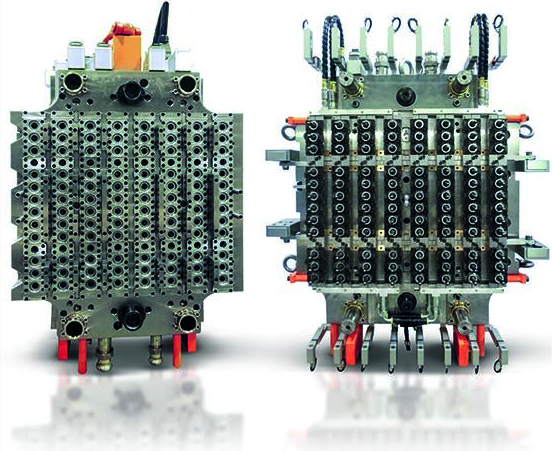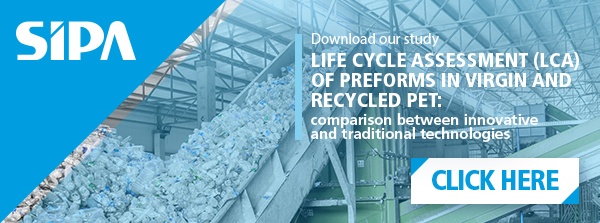
In the production of PET preforms, bottles and containers every company has specific needs that must be satisfied by those supplying the machines and moulds to manufacture them.
Converters and bottlers are always looking for solutions that bring manufacturing advantages for their operations, both when they are putting a relatively low number of PET preforms or filled beverage bottles onto the market, and when the production volumes are high.
Let us look at the characteristics that determine the quality of preform machines and moulds.
Number of cavities in moulds for PET preforms
Generally speaking, preform moulds can have from 8 to 180 cavities, but the market tells us that the types most frequently used by companies are those with 48, 72, 96, 128 and 144 cavities.
There are considerable differences depending on the various needs of the end consumers of the beverages. In Europe there is a greater demand for moulds with 72 and 96 cavities, whereas in America and China it is 144 cavity moulds that are more frequently purchased and used.
This means that the machines installed in the various factories also differ according to the maximum cavity limit for the moulds that can be used.
REAL ALSO: "How to select PET preform injection moulds"
Relationship between machine, moulds and cavities:
- 500 ton machines, suitable for water bottling companies producing 140,000 bottles per hour, can have a maximum limit of 144 cavities, but, for example, on Sipa machines it is possible to use a mould with 180 cavities.
- 400 ton machines are able to fit moulds with up to 128 cavities. It is necessary to specify that Sipa satisfies the need for a maximum of 128 cavities with a 350 ton machine.
- 300 ton machines will take moulds with up to 96 cavities. In this case Sipa offers a 250 ton option.

The main factors that result in manufacturing advantages for companies are essentially two: number of cavities and cycle time. Let us now analyse each of these technical characteristics in more detail.
Preform mould with maximised number of cavities
The increase in productivity in preform manufacturing systems can be achieved in various ways, one of which is to maximise the number of cavities.
Typically the number of cavities depends on:
- Maximum available closing force (tonnage)
- Dimensions of the plasticization systems
- Dimensions of the press platens surface
If the first two points listed allow, it is possible to design a mould cavity layout (arranging the cavities with a horizontal and vertical step) that will maximise their number.
For example, thanks to the use of a “micro-pitch” layout, it is possible to optimise moulds, going from 48 to 72 cavities, from 72 to 96, from 96 to 128, from 144 to 180.
A typical example of this is the 180 cavity mould as an evolution of the 144 cavity mould. The latter has the cavities arranged in 8 vertical rows of 18 cavities each.
When the size of the components is compacted, it is possible to have an arrangement of 10 rows with 18 cavities each in the same space, thus giving a total of 180 cavities.
The increase in productivity is obvious, particularly when analysing the figures.

With an optimised 180 cavity mould and the same cycle time the production increases from 98000 to 122000 units per hour.
To achieve the same result it would have been necessary to reduce the cycle time from 5.3 to 4.25 seconds, a value that is practically unachievable at the present time.
High performance mould for PET preforms
Having a high performance mould means gaining an advantage in terms of:
- Faster injection (more than 10g/s per cavity)
- Better cooling
- More efficient extraction
Essentially, the result achieved is reduction of the cycle time and, consequently, an obvious increase in productivity.
READ ALSO: "PET preform system: technology and quality of a PET injection mould"
The cycle time is made up of: injection time, maintenance time, cooling time, mechanical press opening and closing time and extraction time.
Earlier we gave an example of a mould that already had a particularly competitive cycle time (5.3s) obtained by applying the best solutions available. Other moulds designed with more modest solutions have margins for improvement that, if applied, may result in an appreciable increase in productivity.
For example, by optimising the various components that make up the cycle time it is possible to make a decided improvement in the production of PET preforms.
The maintenance and cooling times can be dependent on the preform extraction temperature which, in turn, mainly depends on the cooling capacity of the post mould cooling systems.
Here again the figures remove any doubt. Having a good hot runner and a mould with high performance vents can result in an improvement of up to 50% in the injection time.
Also, when a mould with good heat exchange performance is compared with a poor quality mould it can be seen that productivity can vary by as much as 20% - 30%.
The mechanical press opening and closing time depends almost exclusively on the machine and the design of the mould extraction cams, while the ability to cool the preform better outside the mould allows it to be extracted quickly and, therefore, to speed up the entire process.
By working on all these parameters, also tweaking the hardware in the form of mould and machine to optimise them, it is thus possible to gain incredible advantages that can lead to a 30% reduction in the cycle time.





